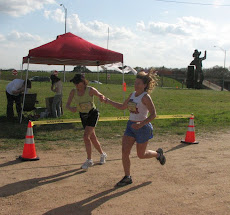Like Texas thunderstorms, races always seem to blow up on you in a hurry. It’s why you learn with experience to take advantage of those early and middle weeks of prep so as not to be caught under-, or worse yet, un-prepared come race day.
I recall wondering before my first marathon if I was really prepared. How would I feel at mile 20, or 22? This is one of the appeals of these things, though it still leaves me somewhat uneasy as I now find myself less than a week away from the CapTexTri. Generally, assuming I don’t flounder badly in the swim, I feel mostly prepared. But here again there is a real difference when compared to training for running events. In the case of a marathon, or half-marathon, you have trained by running, and then running some more. As a rookie triathlete, I wonder if I have given enough attention to each of the disciplines. I may have mentioned previously that I feel unfaithful to my original mistress, running. I am sure other triathletes, coming from cycling or swimming backgrounds, must feel the same. Believe it or not, I have missed the weekly long runs of 12-15 miles, an essential element in distance training. But, of course, I didn’t dare expend that much energy on running while still a newcomer to cycling and swimming. Time will tell, and time will accelerate as well, as the final days of tapered training come around.
 Beach to Bay
Beach to Bay
I must admit that I did focus upon running this past weekend as my Mid-Texas Symphony running team made its second run at the Beach to Bay Relay Marathon in Corpus Christi. This year’s team was slightly reconfigured from last year’s bunch, but remains by employment or familial ties connected to the Mid-Texas Symphony. We thought we might have ended up allowing a non-musician onto the team when we asked Fred Ramirez, hubbie of Dorian, to join us, but it turns out Fred is a former trumpet and baritone player. He’s also, with Dorian, in his second year of triathlon. So, how’d we do? Not bad, he replied, despite the need for some creative logistics. Bottom line is we finished in 3 hours 38 minutes 10 seconds, not bad for a bunch of musicians. The funny thing is we shaved almost 5 minutes off what we ran last year. What's so funny about that? Read on.....
Now I’m the slowest (also the oldest, if that even makes a difference). The young doc-to-be Jonathon Hager is the race horse, which is why we have run him at anchor both years. This year, however, part of the team, including Jon, was staying on Padre Island. This was great for me and Jon’s dad, Steve, since we both had early legs which required us to start on the island. By the time the first wave of runners was finished on the 4 miles of beach (I ran this leg for our team), a Texas sized traffic jam was forming as runners, shuttle buses, and spectators all headed towards the causeway at once. It was bumper to bumper for 8 miles and took almost 2 hours for me to get across and reunited with my leg 2 and 3 runners. Unfortunately, Jon got caught in the mess as he was driving to his handoff point. We all assumed the worst, that we would just have to write off this year’s race to experience. But surprisingly, despite Dorian of leg 5 having to wait at the handoff point for 4 minutes while wondering what had become of Jon, the team finish was good enough to place us in the upper 20 percent overall. We got great legs from all the runners.
Weekend athletes like myself and my teammates will often say we do it for the fun and to simply test ourselves against ourselves, and that is true mostly. I know competitors who say, emphatically, I don’t do fun runs. None of the runners on my team (Dorian and Fred Ramirez, Liz Levin Pittel, Jon and Steve Hager, and myself) turn our noses at fun runs, and Beach to Bay definitely is a fun run, in the very best sense. Nevertheless, as several of us reflected the next day on our performance, we thought of how our finishing time might have looked if not for that 4 minute gap.
“But we’re not competitive,” said one teammate. We looked around the circle and each of us understood the coded message. Just wait till next year!
Read More......











